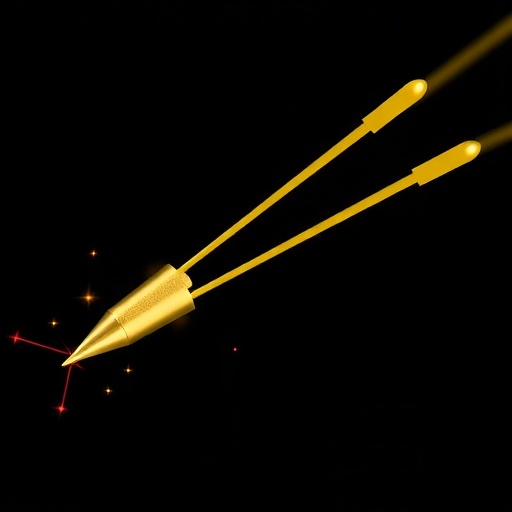In a groundbreaking advancement poised to revolutionize nanotechnology and biomedical imaging, a team of researchers from the University of Tokyo has unveiled unprecedented insights into the structural evolution of gold nanoclusters in their embryonic stages. Led by Principal Investigator Tatsuya Tsukuda, along with Shinjiro Takano and Yuya Hamasaki, this research charts a meticulous course through the nucleation and anisotropic growth of gold clusters, culminating in the discovery of a novel form they’ve termed “gold quantum needles.” Published in the Journal of the American Chemical Society, these findings not only illuminate the fundamental processes underlying nanocluster formation but also hint at transformative applications in high-resolution imaging and energy conversion technologies.
Gold, often associated with ornamental or financial value, possesses unique attributes at the nanoscale, where its physical and chemical properties diverge dramatically from its bulk counterpart. Specifically, gold nanoclusters composed of fewer than 100 atoms exhibit quantum phenomena that are highly sensitive to their geometry and electronic structure. However, controlling the synthesis of such clusters with precise size, shape, and composition has remained a formidable challenge in nanochemistry, partly due to a limited understanding of the early-stage growth mechanisms that dictate their final morphology.
Recognizing this gap, the research team engineered atypical synthesis conditions designed to trap gold clusters at their seminal growth stages. Employing single-crystal X-ray diffraction—a technique that deciphers atomic arrangements within crystalline materials—they unveiled that gold nanoclusters don’t simply grow uniformly but do so anisotropically, expanding at different rates along different axes. This deviation from isotropic growth defies simplistic assumptions and provides a fresh perspective on how nanocluster shape can be directed through manipulation of growth kinetics.
Perhaps most strikingly, the investigations revealed a previously unobserved structural motif: elongated, pencil-shaped nanoclusters constructed from triangular trimers and tetrahedral tetramers of gold atoms. These structures, named “gold quantum needles,” display quantized electronic behavior arising from the confinement of electrons within their unique geometry. In quantum mechanics, such confinement leads to discrete energy states, which are central to the unprecedented optical properties these nanoclusters exhibit — especially their responsiveness to near-infrared light.
This responsiveness to near-infrared wavelengths is not merely a scientific curiosity but carries profound implications. Near-infrared light penetrates biological tissues more deeply and with less damage compared to visible light, making gold quantum needles promising agents for next-generation biomedical imaging techniques. Their ability to interact with light efficiently positions them as excellent candidates for enhancing imaging resolution or even facilitating light-driven therapeutic interventions, a pursuit that remains at the forefront of medical nanotechnology.
Exploring the genesis of these quantum needles, Tsukuda elaborates that their formation diverges markedly from the conventional spherical clusters typically observed during gold nanocluster synthesis. Instead of a compact, roughly spherical geometry, these clusters initiate with a triangular base of three gold atoms, setting a foundation for anisotropic elongation. This serendipitous discovery underscores how subtle alterations in experimental conditions can yield entirely new structural classes, expanding the creative toolbox of materials scientists.
The study’s deeper significance lies in its contribution to demystifying the so-called “black box” of nanocluster formation. Prior to this work, the precise nucleation dynamics and the pathways favoring different morphologies were largely speculative. By providing “structural snapshots” of clusters at various growth phases, the research charts a detailed map of how tiny gold seeds transform stepwise into complex architectures. This not only enables predictive control over cluster design but also unlocks the potential for tuning electronic and optical properties with unprecedented accuracy.
According to the team, the refined synthesis protocols employed here involve controlled reduction of gold precursor ions in the presence of protective thiolate ligands. These surface ligands safeguard nascent clusters from uncontrolled aggregation and provide an interactive platform influencing growth directionality. The intricate interplay between ligand chemistry and gold atom assembly is pivotal in steering cluster anisotropy and dimensionality.
Going beyond mere observation, the researchers envision leveraging this newfound understanding to engineer other novel gold-based nanostructures with tailored optoelectronic properties. Future endeavors include refining the synthetic parameters to access a broader spectrum of shapes and sizes, potentially leading to materials with customized responses for specific applications, such as catalysis, sensing, or photonics.
In addition, interdisciplinary collaborations are on the horizon to harness the remarkable optical capabilities of gold quantum needles. Their near-infrared absorption efficiency, combined with quantum confinement effects, makes them ideal candidates for integration into biomedicine, particularly in techniques requiring deep tissue penetration or localized photothermal therapies. The team is optimistic about translating these fundamental insights into practical technologies that could redefine diagnostic and therapeutic paradigms.
This research represents a synthesis of advanced experimental techniques and conceptual innovation, bridging a significant gap between theoretical understanding and practical synthesis of functional nanomaterials. By illustrating the anisotropic nucleation and stepwise growth of these gold clusters, the study sets a benchmark for future investigations seeking to manipulate matter at the atomic scale with surgical precision.
Ultimately, the emergence of gold quantum needles embodies a paradigm shift in nanochemistry, opening avenues not just for academic inquiry but for impactful applications that harness the intersection of quantum physics, materials science, and biomedical engineering. The journey from the nucleation of three gold atoms to fully formed quantum needles heralds a new chapter where the deliberate design of nanomaterials transcends previous limitations, offering a robust platform for innovation.
Subject of Research: Not applicable
Article Title: X-ray Crystallographic Visualization of a Nucleation and Anisotropic Growth in Thiolate-Protected Gold Clusters: Toward Targeted Synthesis of Gold Quantum Needles
News Publication Date: 5-Sep-2025
Web References: http://dx.doi.org/10.1021/jacs.5c11089
Image Credits: Takano et al 2025
Keywords
Gold nanoclusters, anisotropic growth, nucleation, quantum needles, single-crystal X-ray diffraction, near-infrared optical properties, nanotechnology, quantum confinement, thiolate ligands, nanomaterials synthesis, biomedical imaging, photothermal therapy
Tags: anisotropic growth of nanoclustersbiomedical imaging breakthroughscontrolled synthesis of nanostructuresearly-stage growth mechanisms in nanochemistryenergy conversion technologiesgold nanoclusters structural evolutiongold quantum needleshigh-resolution imaging applicationsnanoscale gold propertiesnanotechnology advancementsquantum phenomena in nanomaterialsUniversity of Tokyo research discoveries





